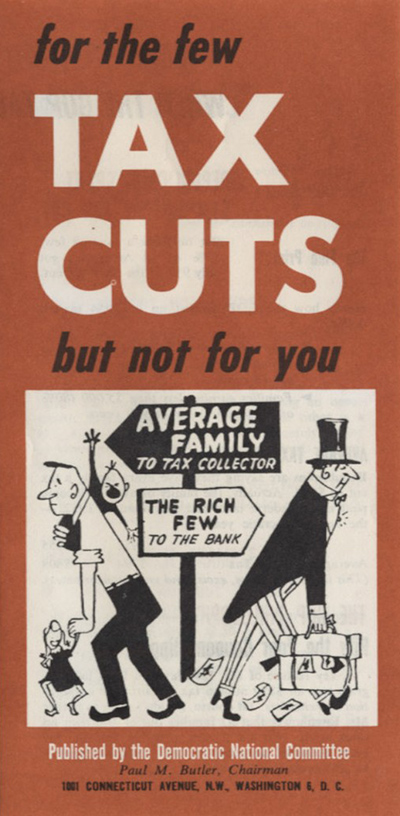
“Tax Cuts: For The Few But Not For You” pamphlet, ca. 1956.
Cornell’s Political Campaign Memorabilia Collections
For more than 200 years, Presidential campaigns have relied partly on material culture to attract votes. Most elections have inspired and made use of objects—jewelry, bandanas, walking sticks, ceramic plates, lapel ribbons, buttons, bumper stickers—for partisan purposes. Commemorative items celebrate centennials, honor American leaders, or lament their passings. This material culture, along with paper ephemera such as cartoons, prints, and posters, can inform the study of more conventional documentary sources on American political history. Political memorabilia are a particularly rich resource for understanding the transformation of American politics across the 19th and 20th centuries, documenting expanding avenues of activism and electioneering, shifting political party platforms, and the culture of nominating conventions. Beyond their immediate goal of promoting political candidates and their parties, these physical objects also served to simplify complex personalities and issues, and generate and maintain emotional bonds between candidates and constituencies. Through their texts, imagery, design and materials, campaign memorabilia offer direct access to lives of everyday people and their concerns.
Political campaign memorabilia became a focus at Cornell in 1957, when Cornell Library’s Dept. of Manuscripts and University Archives (now part of Cornell's Rare and Manuscript Division in the Carl A. Kroch Library) began receiving a large gift of 5,500 campaign items collected by by Susan H. Douglas. Dating between 1789 and 1960, the Douglas collection includes ballots, three-dimensional objects, broadsides, buttons, cartoons, maps and charts, pamphlets, parade items, posters, prints, ribbons, sheet music, songbooks, textiles, trinkets, wearing apparel, and souvenirs of all kinds such as plates, cups, vases, coins, trays, bottles, plaques, busts, statues, clocks, sewing boxes, and games.
Since the 1960s, additional materials arrived regularly by donation. Each political campaign season attracted multiple gifts from members of the public. Other collectors who spent decades developing their own collections of political memorabilia over the past 50 years, such as Robert Pons and Bob Shultz, have also donated them to the Library. Political campaign documentation can be found in many other archival collections in the Library’s Rare and Manuscript Division, such as the Lindseth Collection on American Woman Suffrage, the Barack Obama presidential campaign and inauguration collection, the archives of advocacy and human rights organizations in the Human Sexuality Collection, the 1960-1966 public relations records of the Republican National Committee, and the PJ Mode Collection of Persuasive Maps.

Canvas bag with shoulder strap, contains the slogan “VOTES / FOR / WOMEN” in green and purple on one side, ca. 1920.
Grant Project to Preserve and Digitize the Collection
In 2001, the Institute of Museum and Library Services (IMLS), a primary source of federal support for the nation's libraries and museums, awarded Cornell University Library a two-year National Leadership Grant in Preservation or Digitization of Library Materials. This grant funded the conservation, digitization and cataloging of the Cornell University Political Americana Collection from October 2001 to September 2003 in order to make the digitized images and catalog information freely available and searchable. The National Leadership Grant Program’s Preservation or Digitization of Library Materials category enabled libraries to preserve and digitize valuable library resources in innovative ways. The grant was awarded to model projects that offered far-reaching impact throughout the library community.
In addition to the 5,500 items in the Douglas collection, Cornell University Library conserved, digitized, and cataloged approximately 1500 other similar items covering Presidential campaigns from 1960 to 1972, and 393 individual pieces of printed campaign literature dating from 1800 to 1964 from the rare book collections.
All of the original artifacts and printed materials were preserved through rehousing and selective conservation treatment, then scanned using either grayscale or color flatbed scanners, a digital camera, or traditional photography combined with negative scanning. The exact method was determined by the nature of the original object. Item-level catalog records based on an existing item-level indexing system were created,